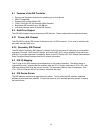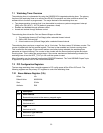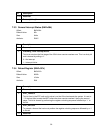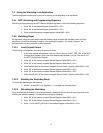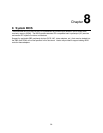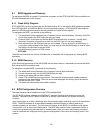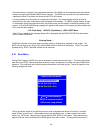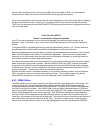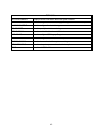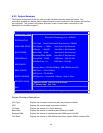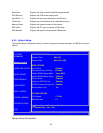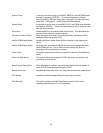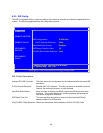39
8.1 BIOS Upgrade and Recovery
To reprogram the BIOS or update it if it becomes corrupted, use the DTIFLASH.EXE utility available from
DTI and discussed later in this chapter.
8.1.1 Flash Utility Program
DTIFLASH.EXE is a utility program that can be obtained from DTI in the event a BIOS should be updated.
Run DTIFLASH.EXE to modify the BIOS in the on-board flash memory. DTIFLASH.EXE eliminates the
need for a PROM programmer and for removing boards and chips from the system.
To reprogram the BIOS , you should do the following:
1) The latest flash will be distributed via a Customer Service Alert Notification. Normally, the BIOS
zip file also contains the DTIFLASH.exe utility you need.
2) Create a DOS 6.2 boot disk and add the BIOS file and flash utility to the disk. Usually other
Windows* boot disks will work fine as well, but use DOS if you run into any problems.
3) Boot the board from the DOS boot disk you just created. You can do this via a USB Floppy. If
your system does not boot off the floppy you may need to enter the BIOS setup in order to move
the floppy to the first item in the boot order.
4) Use the following syntax at a DOS prompt:
DTIFLASH
The BIOS zip file should also contain a Readme file or installation file to help guide you through BIOS
installation.
8.1.2 BIOS Recovery
In the event that the contents of the BIOS ROM are corrupted, there is a mechanism to recover the BIOS
Rom using the BIOS bootblock code.
To reprogram corrupted BIOS, you should do the following:
1) The latest flash will be distributed via a Customer Service Alert Notification.
2) Format a disk and copy only the BIOS ROM file to the disk.
3) Power on the board with the disk installed.
4) Press CTRL+HOME keys during power on. The board will enter automatic update mode and
program the file from the disk. There will be no video displayed, but activity should be seen on
the disk and the POST LEDs.
5) The board will automatically reboot after complete.
8.2 BIOS Configuration Overview
This topic presents a brief introduction to the DTI Embedded BIOS.
The DTI BIOS Software supports all of the IBM /AT standard functions and several functions and
features. Features of the DTI BIOS include built-in utilities, help windows, and system monitoring
functions.
Upon initial power up or after a hardware reset, the processor begins executing code out of the onboard
BIOS. The BIOS contains all of the software needed to boot the board to a working state so an
operating system can be loaded. The first order of business for the BIOS is to initialize crucial system
components, such as timers and chipset parts. The BIOS then performs basic components checks to
ensure their presence and then sets them to a default state. Next, the cache and memory controllers
must be initialized and configured for the type and configuration of the cache and memory found in the
system.



